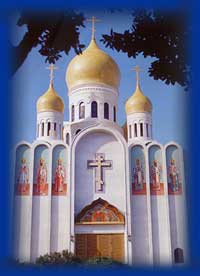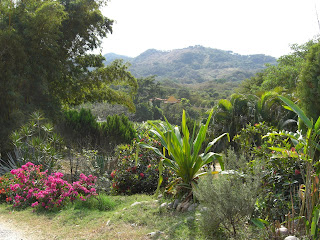One of my favorite places in San Francisco is Holy Virgin Joy of All Who Sorrow Cathedral, out in the western part of the city (26th and Geary).

It is built in traditional Novgorod style, which means that it has five cupolas: a big central one and four smaller at each corner of the high, square box. I happened to have known the iconographer who covered its walls with stuinning fresci - the Archimandrite Kiprian of Jordanville. When I was eighteen, I spent part of a summer at Holy Trinity Monastery, where he was one of three founders, with the rank of archimandrite. He was the overseer of the farm work, and so I basically worked for him. He thought I was very industrious (obviously, Archimandrite Kiprian did not possess the charism of clairvoyance!), because he once caught me disking a field unbidden. He was overjoyed that someone my age would do something that needed doing on his own initiative. Little did he know that I just enjoyed driving the tractor.
Fr. Kiprian spent most of his time, however, painting icons. He was a master muralist, painting them right on the walls of the churches in fresco. The Cathedral of the Holy Trinity in Jordanville (near Herkimer, NY) is a little-known jewel, as is the SF Cathedral. The style is I guess what you would call Russian National (borrowing that term from architecture). It is obviously new, but at the same time it is inspired by medieval Russian iconography (pre-18th Century). There is a lot of gold and red. And the whole interior of the cathedral is covered with it. It is really quite stunning.
On Saturday night, I fulfilled my obligation “to worship God every Sunday in His Church" by attending the All-night Vigil there. The choir was very good. A high point for me was the Phos hilaron (sv'et'e tikhi) sung in Slavonic but with a dandy Georgian setting in the classic Gurian style, which is so atonal that it sounds 20th C., although it is nearly a thousand years old. Stravinsky said he was influenced by this kind of thing.






















In addition to the murals, the interior of the church is a sumptuous as anything to be found in Russia. There are no pews, of course, but benches are provided at the back for the elderly and infirm (such as Yours Truly). Five enormous crystal chandeliers hang under the cupolas. They are turned on and off at various times during the Vigil to indicate cartain parts of the rite. The iconostas is completely gilded, and there are two side chapels ~ each an altar behind its own iconostas, which makes this church what the Russians call a collection or sobor. Many large churches have this feature, and they are all called sobori. This word is conventionally translated as cathedral, and so it is a bit confusing. Not every sobor is a cathedral, in the Western sense.
It is still pre-Lent in the Orthodox Church, and the clergy were arrayed in beautiful light-blue vestments. I got there early, in time for the endless akathist in honnor of the places great patron, St. John Wonderworker of San Francisco. That is Archbishop John Maximovich of Shanghai and San Francisco, who organized the building of the Cathedral. He was a small, apish man, about whom I remember hearing 45 years ago at Jordanville, where everyone already regarded him as a saint. He went around barefoot and carried heavy chains under his habit. As Bp. Kallistos (Ware) once observed, "he was very ascetic, and hardly ever slept, except at diocesan council meetings,." he was also famous for making everyone wait while he got down on the floor to play with the children. Now he rests under a fabulously carved, gilded canopy, in a golden glass-topped casket, where the faithful (and goyim like Yours Truly) may venerate his incorrupt remains. Only his hands are exposed to this adulation, his face is modestly covered with a chalice veil.
Saint John The Wonderworker 

Speaking of Bp. Kallistos, he is doing a couple of lectures this weekend at the Greek Cathedral in Oakland, which I intend to attend. Timothy Ware, in the world, was an Oxford don who converted in the 60s and became a monk on Patmos, and then titular bishop of some tiny island now controlled by Turkey. I just learned from Wikipedia that Lord Kallistos is now a metropolitan, the Ecumenical Patriarch of Constantinople having elevated the diocese to the status of a metropolitanate.


















